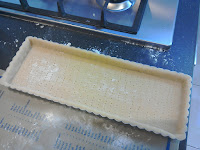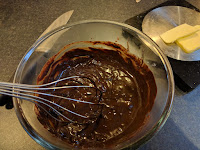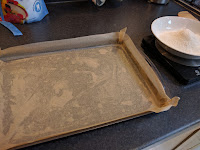This was my second attempt at doing a coffee and walnut tart...the first one was inflicted on some cyclists, and the feedback was that there needed to be more walnut, and the coffee was either right, or not quite strong enough (cyclists love their coffee!).
For this one, I used a much deeper tart tin (so more frangipane), put a lot more walnut pieces in, and also put a chocolate ganache on top. The coffee caramel sauce was basically the same. It certainly baked well, and generally happy with how it looks! I think it might want more chocolate on top (I used the same recipe as I used for the opera cake, but I have a large jar of it left). It's effectively a chocolate brownie tart at this point!
Make the coffee-caramel ahead of time, and store it in an airtight jar in the fridge. You won't need all of it, but a teaspoon of it makes a great addition to a cup of hot chocolate!
1) Mix the milk and coffee granules, removing any dry lumps, to soft a thick (and very bitter, don't lick the spoon) blend

2) Place the sugar and water in a small saucepan over a medium heat
3) Heat the water and sugar until the sugar has all dissolved, then turn the heat up a little
4) Keep boiling the mixture until it turns a golden brown (this will happen quite quickly, be ready to take it off the heat quickly!)
5) Remove from the heat and whisk in the butter and cream

6) Pour in the coffee mixture and continue to whisk
7) Once fully mixed and combined, return to a low heat until the mixture just begins to boil again
8) Pour into a large jar, and leave to cool and thicken (best done overnight)
9) Pre-heat the oven to 180-190'C
1) Put the flour, sugar, salt and butter into a food processor with the blade attachment
2) Whizz until the mixture until it resembles breadcrumbs
3) Add the egg while still mixing
4) Slowly add the water until a dough just begins to form (you may not need all of it)
5) Turn the mixture out into a cold bowl, and knead a few times until a dough forms

6) Flatten it to a disc, wrap it in cling-film, and chill it for 30 minutes
7) Once chilled, place on a lightly floured surface, and roll out to 3-4mm thickness in a circle large enough to line a deep 23cm tart tin
8) Line the tart tin, tucking the sides down, and leaving any spare overhanging
9) Prick the base of the tart with a fork all over
 10) Line the pastry with cling-film and baking beans/dry rice
10) Line the pastry with cling-film and baking beans/dry rice
11) Bake in teh oven for 12 minutes
12) Remove the cling film and beans, then return to the oven for another 7 minutes, until the base of the pastry is just starting to brown a little
13) Remove to a wire rack
14) While the pastry is still hot, take 4-5 tbsp of the coffee-caramel sauce and spread it out over the pastry...the heat of it will soften it, allowing you to form an even layer
15) Trim the spare pastry off the edges of the tart
16) Turn the oven down to 160'C
1) To make the frangipane, put the butter and sugar in a stand mixer with the paddle attachment
2) Mix until light and creamy
 3) Add the eggs, and mix hard until thoroughly combined (you may need to scrape the sides down)
3) Add the eggs, and mix hard until thoroughly combined (you may need to scrape the sides down)
4) Add the ground walnut and flour, and mix until combined
5) Sprinkle the walnut pieces over the coffee-caramel in the tart
6) Put the frangipane into a piping bag, and pipe it over the walnut pieces, filling the tart
7) Bake in the oven for 35-45 minutes, until fully cooked and risen

8) Remove to a wire rack to cool
2) Put the milk in a small saucepan, and heat until just starting to boil
3) Pour the milk into the chocolate and leave for 30 seconds
 4) Whisk until the chocolate has all melted
4) Whisk until the chocolate has all melted
5) Whisk in the butter
6) Leave to cool and thicken slightly
7) Spread over the top of the tart (you won't need all this recipe...place the spare in an airtight jar in the fridge)
For this one, I used a much deeper tart tin (so more frangipane), put a lot more walnut pieces in, and also put a chocolate ganache on top. The coffee caramel sauce was basically the same. It certainly baked well, and generally happy with how it looks! I think it might want more chocolate on top (I used the same recipe as I used for the opera cake, but I have a large jar of it left). It's effectively a chocolate brownie tart at this point!
Make the coffee-caramel ahead of time, and store it in an airtight jar in the fridge. You won't need all of it, but a teaspoon of it makes a great addition to a cup of hot chocolate!
Coffee, Walnut and Chocolate Tart
Coffee-Caramel Ingredients
1) Mix the milk and coffee granules, removing any dry lumps, to soft a thick (and very bitter, don't lick the spoon) blend

2) Place the sugar and water in a small saucepan over a medium heat
3) Heat the water and sugar until the sugar has all dissolved, then turn the heat up a little
4) Keep boiling the mixture until it turns a golden brown (this will happen quite quickly, be ready to take it off the heat quickly!)
5) Remove from the heat and whisk in the butter and cream

6) Pour in the coffee mixture and continue to whisk
7) Once fully mixed and combined, return to a low heat until the mixture just begins to boil again
8) Pour into a large jar, and leave to cool and thicken (best done overnight)
9) Pre-heat the oven to 180-190'C
Sweetcrust Pastry Ingredients
- 300g plain flour
- 120g caster sugar
- 120g cold butter
- Pinch of salt
- 1 egg
- 20-30ml cold water
1) Put the flour, sugar, salt and butter into a food processor with the blade attachment
2) Whizz until the mixture until it resembles breadcrumbs
3) Add the egg while still mixing
4) Slowly add the water until a dough just begins to form (you may not need all of it)
5) Turn the mixture out into a cold bowl, and knead a few times until a dough forms

6) Flatten it to a disc, wrap it in cling-film, and chill it for 30 minutes
7) Once chilled, place on a lightly floured surface, and roll out to 3-4mm thickness in a circle large enough to line a deep 23cm tart tin
8) Line the tart tin, tucking the sides down, and leaving any spare overhanging
9) Prick the base of the tart with a fork all over
 10) Line the pastry with cling-film and baking beans/dry rice
10) Line the pastry with cling-film and baking beans/dry rice11) Bake in teh oven for 12 minutes
12) Remove the cling film and beans, then return to the oven for another 7 minutes, until the base of the pastry is just starting to brown a little
13) Remove to a wire rack
14) While the pastry is still hot, take 4-5 tbsp of the coffee-caramel sauce and spread it out over the pastry...the heat of it will soften it, allowing you to form an even layer
15) Trim the spare pastry off the edges of the tart
16) Turn the oven down to 160'C
Filling Ingredients
- 150g ground walnut (I used a food processor to blitz walnut pieces)
- 150g softened butter
- 150g caster sugar
- 3 eggs
- 75g plain flour
- 100g walnut pieces

1) To make the frangipane, put the butter and sugar in a stand mixer with the paddle attachment
2) Mix until light and creamy
 3) Add the eggs, and mix hard until thoroughly combined (you may need to scrape the sides down)
3) Add the eggs, and mix hard until thoroughly combined (you may need to scrape the sides down)4) Add the ground walnut and flour, and mix until combined
5) Sprinkle the walnut pieces over the coffee-caramel in the tart
6) Put the frangipane into a piping bag, and pipe it over the walnut pieces, filling the tart
7) Bake in the oven for 35-45 minutes, until fully cooked and risen

8) Remove to a wire rack to cool
Ganache Ingredients
1) Break the chocolate into a heatproof bowl2) Put the milk in a small saucepan, and heat until just starting to boil
3) Pour the milk into the chocolate and leave for 30 seconds
 4) Whisk until the chocolate has all melted
4) Whisk until the chocolate has all melted5) Whisk in the butter
6) Leave to cool and thicken slightly
7) Spread over the top of the tart (you won't need all this recipe...place the spare in an airtight jar in the fridge)

















































